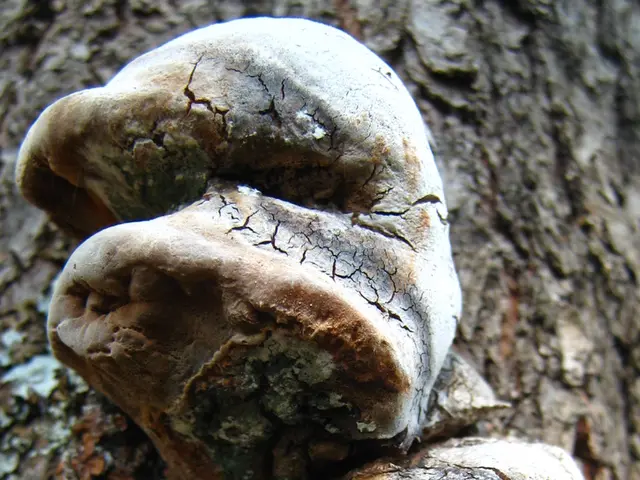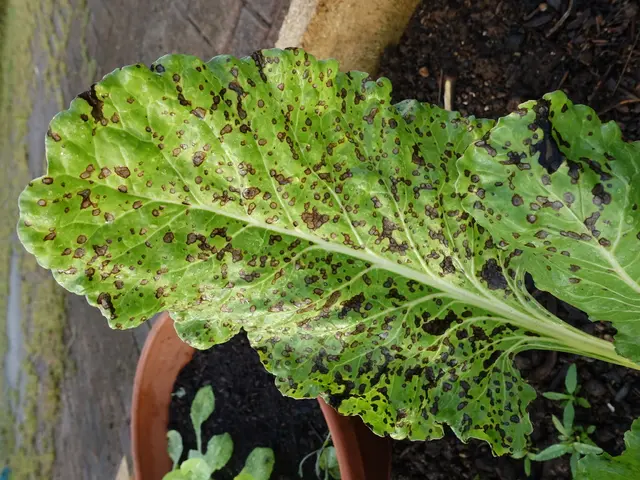Oak trees' caterpillars pose a threat, city council alerts residents
The oak processionary moth (OPM) is a notorious pest that can pose significant health risks to humans and animals. Its caterpillars, known for their distinctive processions and hollow, venomous hairs, can trigger severe allergic reactions and cause a range of symptoms, from mild skin irritation to life-threatening anaphylactic shock.
To minimise the risk of health problems from OPM exposure and treat symptoms effectively, several precautions are recommended. Firstly, it is crucial to avoid contact with trees and areas known or suspected to be infested with the caterpillars. Do not touch the caterpillars, their nests, or any silken "processions" they form. If you must be near infested areas, wear long sleeves, pants, gloves, and eye protection to reduce the risk of skin and eye contact with the caterpillar hairs.
After visiting areas where oak processionary caterpillars are present, wash your hands, face, and clothing thoroughly to remove any loose hairs that may have settled on you. It is also essential to protect pets from exposure, as they are also at risk of irritation, swelling, drooling, gagging, eye irritation, vomiting, or difficulty breathing if exposed.
If you experience itching or a rash, carefully remove any visible caterpillar hairs from your skin (without rubbing them in), wash the affected area with water, and avoid scratching. Over-the-counter antihistamines or topical creams may help relieve symptoms. If caterpillar hairs get into your eyes, rinse them gently with water and seek medical attention if irritation, redness, or pain persists.
In cases of severe allergic reactions, such as swelling of the face or throat, difficulty breathing, or anaphylactic shock, seek emergency medical assistance immediately. If you inhale caterpillar hairs and develop breathing problems or cold-like symptoms that worsen or do not improve, seek medical help promptly.
If your pet exhibits symptoms such as excessive drooling, eye irritation, vomiting, or difficulty breathing after exposure, contact your veterinarian immediately.
Remember, it is not advisable to attempt the removal of nests or infested branches yourself, as improper handling increases the risk of exposure to toxic hairs. Instead, seek professional help for their safe removal.
Be aware of any delayed symptoms following exposure to infested areas, and seek medical advice if symptoms develop or worsen. It is also recommended to monitor municipalities for warning signs, playground closures, or other measures in local areas, particularly around schools or playgrounds.
The oak processionary caterpillar prefers oaks in warm, sunny locations, such as forest edges or solitary trees. To avoid contact, it is advisable to avoid using benches, playgrounds, or grilling areas in close proximity to old oaks in July and August.
Climate change is promoting the further spread of the oak processionary caterpillar, with the insects now found in various parts of Europe. The oak processionary caterpillar has been native to Germany for about 200 years, mainly in the south and the Rhine valley.
In conclusion, by following these precautions, you can significantly reduce the risk of exposure and manage symptoms effectively if they occur. Stay safe and enjoy the outdoors responsibly!
- Science has highlighted the oak processionary moth (OPM) as a pest with potential health risks for humans and animals.
- Its caterpillars can trigger severe allergic reactions and cause various symptoms, from mild skin irritation to life-threatening anaphylactic shock.
- To minimize the risk of health problems from OPM exposure, avoid contact with trees and infested areas.
- In the workplace-wellness sector, it's important to prevent medical conditions like those caused by OPM for employee safety and productivity.
- Cancer treatments can be challenging, but ongoing research in environmental-science offers hope for new therapies and treatments.
- Respiratory conditions like asthma can be exacerbated by poor air quality, making it crucial to monitor and address climate-change-related pollution.
- Digestive health is essential for overall wellness, and nutrition plays a key role in maintaining a balanced gut microbiome.
- Eye-health issues like cataracts and glaucoma can be managed with regular check-ups and medical interventions.
- Hearing loss can be prevented with proper care and protection, such as using earplugs during loud activities.
- Health and wellness industries are expanding to encompass not just physical health but also mental health and skin-care.
- Fitness and exercise are vital components of a healthy lifestyle, contributing to cardiovascular health and diabetes prevention.
- Autoimmune disorders can affect various systems in the body, making it essential to seek accurate diagnoses and effective treatments.
- Climate-change impacts on the ecosystem can lead to pest infestations such as the oak processionary moth, spreading to new territories like manufacturing areas.
- In the manufacturing sector, mental-health and well-being should be prioritized for productive and safe work environments.
- Skin-conditions like eczema and psoriasis can be alleviated with appropriate therapies and treatments.
- Hearing aids and cochlear implants are examples of technological advancements in the treatments of hearing loss.
- In the realm of health and wellness, retail ventures are embracing innovative trends such as natural skin-care products and CBD products.
- Entrepreneurship in the health and wellness industry can offer alternatives to traditional medicine and promote well-being through lifestyle changes.
- Interior-design choices can also impact health and wellness, with proper lighting, air quality, and ergonomic furniture promoting productivity and comfort.
- Transportation innovations like electric vehicles and carpooling can help mitigate the negative effects of climate-change on the environment.
- Leadership in the health and wellness sector requires a deep understanding of the industry and a commitment to promoting a culture of health and well-being.
- Diversity and inclusion practices in the health and wellness industry can help break down barriers and promote access to care for all individuals.
- Wearables, smart home devices, and cybersecurity innovations are revolutionizing healthcare by enabling remote monitoring, personalized care, and improved diagnostics.
- Lifestyle choices play a critical role in overall health and well-being, with prioritizing fitness, nutrition, and mental health essential for maintaining optimal health.
- Small businesses in the health and wellness industry can thrive with effective strategies for personal-finance and wealth-management.
- Investing in the health and wellness sector can offer profitable opportunities in areas like private-equity, venture-capital, and real-estate development.
- For consumers, personal-finance management is crucial for enjoying wealth-management strategies and securing a stable financial future.
- Banking and insurance industries play a vital role in providing financial services for healthcare and wellness, facilitating health-care access for millions.
- Financial technologies (fintech) are transforming the banking and insurance industries, offering more convenient and personalized services in the health and wellness sector.








